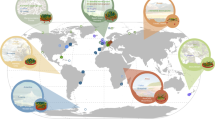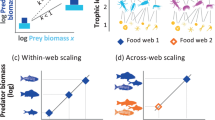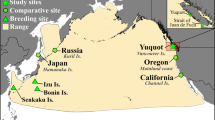Abstract
Many free-ranging predators have to make foraging decisions with little, if any, knowledge of present resource distribution and availability1. The optimal search strategy they should use to maximize encounter rates with prey in heterogeneous natural environments remains a largely unresolved issue in ecology1,2,3. Lévy walks4 are specialized random walks giving rise to fractal movement trajectories that may represent an optimal solution for searching complex landscapes5. However, the adaptive significance of this putative strategy in response to natural prey distributions remains untested6,7. Here we analyse over a million movement displacements recorded from animal-attached electronic tags to show that diverse marine predators—sharks, bony fishes, sea turtles and penguins—exhibit Lévy-walk-like behaviour close to a theoretical optimum2. Prey density distributions also display Lévy-like fractal patterns, suggesting response movements by predators to prey distributions. Simulations show that predators have higher encounter rates when adopting Lévy-type foraging in natural-like prey fields compared with purely random landscapes. This is consistent with the hypothesis that observed search patterns are adapted to observed statistical patterns of the landscape. This may explain why Lévy-like behaviour seems to be widespread among diverse organisms3, from microbes8 to humans9, as a ‘rule’ that evolved in response to patchy resource distributions.
This is a preview of subscription content, access via your institution
Access options
Subscribe to this journal
Receive 51 print issues and online access
$199.00 per year
only $3.90 per issue
Buy this article
- Purchase on Springer Link
- Instant access to full article PDF
Prices may be subject to local taxes which are calculated during checkout


Similar content being viewed by others
References
Stephens, D. W. & Krebs, J. R. Foraging Theory (Princeton Univ. Press, Princeton, 1986)
Viswanathan, G. M. et al. Optimizing the success of random searches. Nature 401, 911–914 (1999)
Bartumeus, F., da Luz, M. G. E., Viswanathan, G. M. & Catalan, J. Animal search strategies: a quantitative random-walk analysis. Ecology 86, 3078–3087 (2005)
Shlesinger, M. F., Zaslavsky, G. M. & Klafter, J. Strange kinetics. Nature 363, 31–37 (1993)
Viswanathan, G. M. et al. Lévy flights in random searches. Physica A 282, 1–12 (2000)
Russell, R. W., Hunt, G. L., Coyle, K. O. & Cooney, R. T. Foraging in a fractal environment: spatial patterns in a marine predator-prey system. Landscape Ecol. 7, 195–209 (1992)
Sims, D. W., Witt, M. J., Richardson, A. J., Southall, E. J. & Metcalfe, J. D. Encounter success of free-ranging marine predator movements across a dynamic prey landscape. Proc. R. Soc. Lond. B 273, 1195–1201 (2006)
Schuster, F. L. & Levandowsky, M. Chemosensory responses of Acanthamoeba castellani: Visual analysis of random movement and responses to chemical signals. J. Eukaryot. Microbiol. 43, 150–158 (1996)
Brockmann, D., Hufnagel, L. & Geisel, T. The scaling laws of human travel. Nature 439, 462–465 (2006)
Sims, D. W. & Quayle, V. A. Selective foraging behaviour of basking sharks on zooplankton in a small-scale front. Nature 393, 460–464 (1998)
Bradshaw, C. J. A., Hindell, M. A., Sumner, M. D. & Michael, K. J. Loyalty pays: potential life history consequences of fidelity to marine foraging regions by southern elephant seals. Anim. Behav. 68, 1349–1360 (2004)
Houghton, J. D. R., Doyle, T. K., Wilson, M. W., Davenport, J. & Hays, G. C. Jellyfish aggregations and leatherback turtle foraging patterns in a temperate coastal environment. Ecology 87, 1967–1972 (2006)
Mackus, D. L. & Boyd, C. M. Spectral analysis of zooplankton spatial heterogeneity. Science 204, 62–64 (1979)
Makris, N. C. et al. Fish population and behaviour revealed by instantaneous continental shelf-scale imaging. Science 311, 660–663 (2006)
Steele, J. H. The ocean ‘landscape’. Landscape Ecol. 3, 185–192 (1989)
Bartumeus, F., Catalan, J., Fulco, U. L., Lyra, M. L. & Viswanathan, G. M. Optimizing the encounter rate in biological interactions: Lévy versus Brownian strategies. Phys. Rev. Lett. 88, 097901 (2002)
Sims, D. W., Righton, D. & Pitchford, J. W. Minimizing errors in identifying Lévy flight behaviour of organisms. J. Anim. Ecol. 76, 222–229 (2007)
Benhamou, S. How many animals really do the Lévy walk? Ecology 88, 1962–1969 (2007)
Edwards, A. M. et al. Revisiting Lévy flight search patterns of wandering albatrosses, bumblebees or deer. Nature 449, 1044–1048 (2007)
Boyer, D. et al. Scale-free foraging by primates emerges from their interaction with a complex environment. Proc. R. Soc. Lond. B 273, 1743–1750 (2006)
Bartumeus, F., Peters, F., Pueyo, S., Marrasé, C. & Catalan, J. Helical Lévy walks: adjusting search statistics to resource availability in microzooplankton. Proc. Natl Acad. Sci. USA 100, 12771–12775 (2003)
Bartumeus, F. Lévy processes in animal movement: an evolutionary hypothesis. Fractals 15, 151–162 (2007)
Ropert-Coudert, Y. & Wilson, R. P. Trends and perspectives in animal-attached remote sensing. Front. Ecol. Environ. 3, 437–444 (2005)
Myers, A. E. & Hays, G. C. Do leatherback turtles Dermochelys coriacea forage during the breeding season? A combination of data-logging devices provide new insights. Mar. Ecol. Prog. Ser. 322, 259–267 (2006)
Bradshaw, C. J. A. & Sims, D. W. Solutions to problems associated with identifying Lévy walk patterns in animal movement data. J. Anim. Ecol. (submitted)
Viswanathan, G. M. et al. Lévy flight search patterns of wandering albatrosses. Nature 381, 413–415 (1996)
Brierley, A. S. et al. Use of moored acoustic instruments to measure short-term variability in abundance of Antarctic krill. Limnol. Oceanogr. Methods 4, 18–29 (2006)
Field, I. C., Bradshaw, C. J. A., Burton, H. R., Sumner, M. D. & Hindell, M. A. Resource partitioning through oceanic segregation of foraging juvenile southern elephant seals (Mirounga leonina). Oecologia 142, 127–135 (2005)
Perry, G. & Pianka, E. R. Animal foraging: past, present and future. Trends Ecol. Evol. 12, 360–364 (1997)
McMahon, C. R. & Hays, G. C. Thermal niche, large-scale movements and implications of climate change for a critically endangered marine vertebrate. Glob. Change Biol. 12, 1330–1338 (2006)
Chatfield, C. The Analysis of Time Series 6th edn (Chapman & Hall, London, 1996)
Acknowledgements
This research was facilitated through the European Tracking of Predators in the Atlantic (EUTOPIA) programme in the European Census of Marine Life (EuroCoML). Funding was provided by the UK Natural Environment Research Council (NERC) grant-in-aid to the Marine Biological Association of the UK (MBA), the NERC ‘Oceans 2025’ Strategic Research Programme (Theme 6 Science for Sustainable Marine Resources), UK Defra, The Royal Society and the Fisheries Society of the British Isles. D.W.S. thanks G. Budd, P. Harris, N. Hutchinson and D. Uren for field assistance. G.C.H. thanks Ocean Spirits Incorporated, J. Houghton and A. Myers for logistical help in the field. A.S.B. thanks E. Murphy, M. Brandon, R. Saunders, D. Bone and P. Enderlein for their contributions to mooring sampling at South Georgia. NERC Plymouth Marine Laboratory provided L4 zooplankton data. This research complied with all animal welfare laws of the countries or sovereign territories in which it was conducted. D.W.S. was supported by a NERC-funded MBA Research Fellowship.
Author Contributions D.W.S. conceived and planned the study, led the data analysis and wrote the manuscript. All co-authors contributed to subsequent drafts. Field data of animal movements and/or prey distributions were collected by D.W.S., E.J.S., J.D.M., G.C.H., C.J.A.B., A.S.B., M.A.H., D.M., M.K.M., D.R., V.J.W. and R.P.W. The simulation model was conceived by N.E.H. and D.W.S. with N.E.H. writing the programming code. J.W.P. and A.J. were responsible for analysis of projections of 3D Lévy movements, M.Z.A. and E.L.C.S. coded the power spectrum analysis, C.J.A.B. completed the relative likelihood modelling, and G.C.H. and M.J.W. provided additional data analysis.
Author information
Authors and Affiliations
Corresponding author
Supplementary information
Supplementary Information
The file contains Supplementary Figures S1- S3 with Legends and additional references. (PDF 1323 kb)
Rights and permissions
About this article
Cite this article
Sims, D., Southall, E., Humphries, N. et al. Scaling laws of marine predator search behaviour. Nature 451, 1098–1102 (2008). https://doi.org/10.1038/nature06518
Received:
Accepted:
Issue Date:
DOI: https://doi.org/10.1038/nature06518
This article is cited by
-
Links between the three-dimensional movements of whale sharks (Rhincodon typus) and the bio-physical environment off a coral reef
Movement Ecology (2024)
-
Exponential increase of transition rates in metastable systems driven by non-Gaussian noise
Scientific Reports (2023)
-
Common features in spatial livestock disease transmission parameters
Scientific Reports (2023)
-
Plasmodium sporozoite search strategy to locate hotspots of blood vessel invasion
Nature Communications (2023)
-
Multiple Strategies Boosted Orca Predation Algorithm for Engineering Optimization Problems
International Journal of Computational Intelligence Systems (2023)
Comments
By submitting a comment you agree to abide by our Terms and Community Guidelines. If you find something abusive or that does not comply with our terms or guidelines please flag it as inappropriate.



